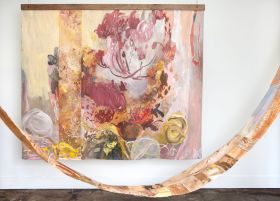There is a dramatic change of mood as you step from the old-world charm of the Adelaide Railway Station concourse and into the temporary home of Samstag Museum of Art, where James Newitt and Emily Wardill are exhibiting. A threshold has been crossed: you have entered a darkened bunker with no fixtures and fittings.
Instead there are flashing lights and a disjointed mix of conversations, accompanied on occasion by the wonderful vocals of Jacques Offenbach’s Olympia’s aria ‘Les oiseaux dans la charmille’. These are the sounds of two films both calling for your attention. Through to the right is a cool, fictional narrative work by Australian artist James Newitt entitled HAVEN; or go left towards the delicious operatic voice and discover the work of UK artist Emily Wardill in Night for Day.
Access to the work from Newitt is via a museum display case loaded with documentation, evidence that on further study reveals itself as a fiction. Newitt’s work is a ‘what if’ proposition – it could be true, but it’s probably not. The exhibition is billed as immersive, and Newitt’s piece is a three-channel work (three screens, three projectors), but it is hard to justify calling it immersive.
Wardill’s single screen work is just as fictional as Newitt’s but less brittle. It’s unashamedly voyeuristic. ‘I started to look into other people’s houses’ says a text on the screen, as a camera positioned outside pans slowly across the rooms of a high-rise apartment building. This feels like an uncomfortable experience. Private lives are on view here and we are watching.
Christina Li explains in the catalogue essay that: ‘together James Newitt and Emily Wardill take a critical look at how technology has shaped recent history, current realities and our future imaginations in the time of apparent political and ideological impasse’.
These works cannot be easily described in a review because they are firmly located within their genre. Explaining them in words doesn’t work, just as describing the colour, the drips and splashes of Pollock’s Blue Poles won’t get you any closer to knowing and understanding the art.
Li writes: ‘[Hewitt’s Haven is an] ongoing enquiry into island utopias and conflicted situations. Incorporating found footage, animation, sound and documentary material, it is informed by the real-life ventures of speculative investors and pirate entrepreneurs – people in search of new structures or forms of living.’
Wardill’s Night for Day, is a more diary-like study that ‘probes the complexities of perception, imagination and communication’. It ‘constructs a psychologically complex work around a feigned mother-son relationship, exploring utopian visions and the way in which ideologies find expression in people’s lives’, according to Li’s catalogue essay. The voiceover of the three protagonists was edited down from 12 hours of interviews. The work was some two years in the making.
Li’s text further draws a comparison between the works: ‘The two films chart the territories and demarcation between humans, organic matter and the machine that challenge the protection of digital content and the fidelity of representing reality in our progressively data-driven world.’
I think this is an unnecessary curatorial justification. These works, for all they may appear self-assured, exist in a fragile space between the objective intention of the artist and the subjective consumption of the viewer. The text gives both too much and too little explanation; indeed, the works need less justification and more context.
This new temporary location of the Samstag Museum presents opportunities for democratisation, but that comes with a challenge. The exhibition will likely be visited by curious commuters unprepared for what they will encounter. A more general introduction to the moving image art genre would be helpful. Film works like these can be puzzling and disappointing to an audience expecting a movie style narrative experience. These are rough chunks of very dark chocolate washed down with a shot of double roasted espresso: definitely not to everyone’s taste, but available at the adjacent café. There is no easily followed narrative in these works, making them difficult to watch especially with a combined running time of 82 minutes and few places to sit.
This official Adelaide Festival event, opened by the new Festival Director, Ruth Mackenzie CBE, and Gallery Director Erica Green, is art that requires a great deal of effort from its audience. Maybe that’s what we should expect from a sanctioned Festival exhibition – not something to simply consume but something to think about.
Read: Exhibition review: Peter Booth, TarraWarra Museum of Art
And why, you may ask, is the prestigious and beautifully fitted out Samstag Art Museum slumming it at the railway station? Unfortunately 3000 litres of water from a broken high-pressure pipe flooded the immaculately cared for space, then seeped under the floor. That misfortune has created a surprising opportunity and unearthed an intriguing new art space.
HAVEN by James Newitt, Night for Day by Emily Wardill
HAVEN and Night for Day will be playing at the Adelaide Railway Station (North Eastern Concourse) until 19 May 2023 as part of the Adelaide Festival; free access.





